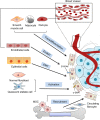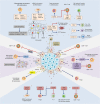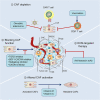Cancer-associated fibroblasts: an emerging target of anti-cancer immunotherapy
- PMID: 31462327
- PMCID: PMC6714445
- DOI: 10.1186/s13045-019-0770-1
Cancer-associated fibroblasts: an emerging target of anti-cancer immunotherapy
Abstract
Among all the stromal cells that present in the tumor microenvironment, cancer-associated fibroblasts (CAFs) are one of the most abundant and critical components of the tumor mesenchyme, which not only provide physical support for tumor cells but also play a key role in promoting and retarding tumorigenesis in a context-dependent manner. CAFs have also been involved in the modulation of many components of the immune system, and recent studies have revealed their roles in immune evasion and poor responses to cancer immunotherapy. In this review, we describe our current understanding of the tumorigenic significance, origin, and heterogeneity of CAFs, as well as the roles of different CAFs subtypes in distinct immune cell types. More importantly, we highlight potential therapeutic strategies that target CAFs to unleash the immune system against the tumor.
Keywords: Cancer immunotherapy; Cancer-associated fibroblasts; Heterogeneity; Immune suppression.
Conflict of interest statement
The authors declare that they have no competing interests.
Figures




References
Publication types
MeSH terms
LinkOut - more resources
Full Text Sources

